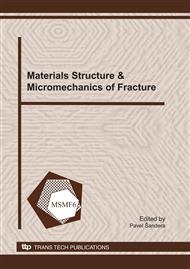p.85
p.89
p.93
p.97
p.101
p.105
p.111
p.115
p.119
Stress Relaxation in an AZ31 Magnesium Alloy
Abstract:
Stress relaxation tests have been used in order to determine parameters of a possible thermally activated process in AZ31 magnesium alloy. The samples were deformed at a constant initial strain rate of 6.7x10-5 s-1 at various temperatures between room temperature and 300 °C. Stress relaxation, i.e. a decrease in the stress with time, was measured at various stress levels and at various temperatures. An analysis of the stress relaxation curves enabled to estimate the internal stress as a function of the strain and the test temperature. It has been shown that the activation volume is a function of the effective stress independently of the deformation temperature.
Info:
Periodical:
Pages:
101-104
Citation:
Online since:
January 2011
Authors:
Price:
Сopyright:
© 2011 Trans Tech Publications Ltd. All Rights Reserved
Share:
Citation:


